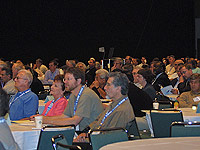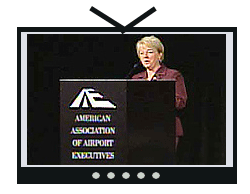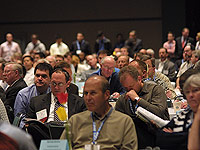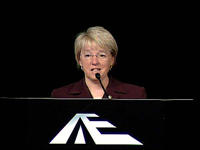(SEATTLE, WA) – Today, U.S. Senator Patty Murray told
|
|
| Watch the Speech |
more than 2,000 airport leaders that the White House and Congress are poised to scale back federal support for airports, modern air traffic control equipment, and security infrastructure.
Murray warned that if these cuts are enacted, they will hinder American aviation, inconvenience passengers, hurt economic development, and raise potential safety concerns. Murray also warned that inadequate support could squander America’s leadership of the global aviation.
|
|
Murray spoke at the 77th annual conference of the American Association of Airport Executives (AAAE). The audience of more than 2,000 included airport managers, security directors, and airport operations chiefs.
Pointing to projections that more people will use air travel in coming years, Murray said that if the federal government pulls back its support, the United States will not be able to meet the new demands for capacity and will forfeit the economic benefits that come from a resurgence in air travel.
|
|
|
Proposed Cuts to Airport Improvement Program Grants
|
|
|
Proposed Cuts to Air Traffic Control Modernization
Outdated air traffic control equipment fails periodically affecting safety, delays and capacity. In some cases, this equipment is more than 30 years old. New equipment is needed to handle the expected growth in flights. Last year, the White House cut funding for modernization $376 million below the previous year. Now, the White House wants to cut modernization funding by $77 million below this year’s spending level.
|
|
Proposed Cuts to Installing Explosive Detection Equipment
The federal government is supposed to provide $500 million each year for installation under the VISION 100 law. This year, however, the White House wants to cut that funding in half – to just $250 million.
|
|
Murray noted that Congress passed a budget blue print that largely follows the President’s funding priorities. Murray said that airport leaders need to tell their Members of Congress how these cuts will hurt their local airports.
……………………………………………………Welcome to an Aviation State
Good morning. I’m excited to welcome all of you to my hometown. Washington state is a place that values aviation. We know that strong airports create jobs, build our economy, and help our country. Washington state is home to 57,000 Boeing employees, and thousands more aviation workers and suppliers. We have a major international airport and the country’s largest runway project. So while you’re here in Washington state, please know that you are among friends.
Frankly, I’m not worried about this Washington. But I am worried about that other Washington –Washington, D.C. – and you should be worried too. That’s because in Washington, D.C. politicians are making decisions that could hurt your airports. And many of them don’t even realize it.
The White House & Congress Are Trying to Cut Airport Investments
This year, the White House and Congress will decide if the Airport Improvement Program will be cut, if you’ll get help installing E.D.S. equipment, if you’ll have a modern air traffic control system, and if America will continue to lead the world in aviation.
Right now, on all those issues, Congress and the White House are headed in the wrong direction. It’s a tight budget year – and there are pressures all around. I want to make sure that our airports understand what’s at stake and speak out with a unified voice, and that’s why I’m here this morning.
The Federal Government Must “Push the Throttle Forward” and Increase Investments
The theme of this conference is “taking to tomorrow’s skies.”
|
|
As I look at those skies, I see a lot of turbulence ahead. Passenger loads are growing, our skies are getting more crowded, our equipment is outdated, and our infrastructure has not kept pace.
As a country, either we’re going to make the investments that ensure our success or we’re going to fail to invest and suffer the consequences of crowded skies, frustrated passengers, and slower economic growth.
As I see it, the federal government can either push the throttle forward and help you succeed, or pull the throttle back and limit the success of our airports, our people and our economy. As I look at the budget so far, I can tell you that the federal government is pulling back, so we’ve got to speak up.
The “Evergreen State” View of Aviation
Many of my colleagues in Congress love airports, but they don’t see how the decisions they’re making today will affect their own local airports tomorrow. That’s why we need leaders like you to stand up and speak out.
Maybe I have a different perspective than other Senators because I was born and raised here in Seattle. Growing up, I saw how every major event in Washington was marked by its impact on the airline industry. It hasn’t always been an easy road. In the early 1970’s, during a massive downturn in the aviation industry, I saw layoffs and economic pain. So many people were moving out of Seattle that someone put up a billboard saying, “Will the last person leaving Seattle turn out the lights.”
Fortunately, the airline industry recovered, but there have been other big bumps in the road. Four years ago, Seattle was rocked by a major earthquake. Just after the quake, one of the first places I visited was Boeing Field. The runway was literally torn apart. I knew we had to repair it because if cargo couldn’t land, our economy couldn’t recover.
Later that year, we saw the horrible events of September 11th. I remember sitting down with Boeing leaders soon afterward and hearing of the huge downturn in aviation. Airlines cancelled their plane orders, and many of my neighbors and constituents were laid-off. I fought with the White House for many months and finally got some relief for our laid-off aviation workers.
So for me, caring about aviation is just something I was raised with. That’s why I’m very troubled by what I see happening today in Congress and why we need strong advocates like AAAE.
AAAE is a Strong Advocate
I’ve been proud to work with Chip Barclay, Todd Hauptli, and their team over the years. I can tell you that you have one of the most effective organizations on Capitol Hill. We’ve stood together in important fights for your airports.
In 2002, we had some real challenges. At the time, I was the Chairman of the Transportation Appropriations Subcommittee. TSA was still in the Department of Transportation, and it needed funding and direction. Passengers were routinely missing flights because they were stuck on endless security lines. Most of the new TSA screeners were brand new on the job. Some were as helpful as a salesman at Nordstrom, but others seemed to have a bayonet between their teeth. Nearly every day, TSA was putting out new rules. Anything TSA couldn’t pay for they expected your airports to pay for. It was an incredibly stressful and expensive time for your industry. During those challenging days, Chip Barclay was a desperately-needed voice of reason. Every Member of Congress wanted a brand new security system overnight. Chip spoke frankly and credibly about what could be accomplished and what couldn’t be accomplished. And while Chip was testifying inside the hearing rooms, Todd was outside in the hallway buttonholing every Member of Congress reminding us that if you want security and efficiency you need to make investments.
More than once, during our late-night conferences with the House — long after all the other lobbyists had gone home — we would find Todd, alone in the hall, waiting to ask how he could help us move things forward.
So I know firsthand how effective your team is in Washington, D.C. That’s important because many elected officials don’t get it. They think that every airport is the same, and they think they can have security on the cheap. But we know better.
Washington’s Airports Show a Range of Challenges
Just look around the airports here in Washington state and you’ll see the wide range of challenges you all face. Here at SeaTac, we were already launching an ambitious expansion plan when 9/11 hit. So the greatest challenge at this airport has been to adjust these plans – in the middle of construction – to meet new security demands. As you may know, we also have the largest – and the oldest – runway construction project in the country. To build our third runway, we’ve had to clear many environmental hurdles. We’ve also built and commissioned a brand new tower and TRACON at the same time.
Our smaller airports have been facing a much different challenge. They have been struggling to hold onto their carriers and their flight frequencies. Our general aviation airports have been trying to comply with all the FAA safety rules at a time of tight revenues.
Airports Under Pressure
|
|
I know that as airport leaders you are under tremendous pressures.Thankfully, more and more passengers are now returning to your airports. But they show up with higher expectations. They now want to clear security as fast as they did before 9/11. They want their luggage the minute they reach baggage claim, and they want shopping and dining options. They want all of those things in facilities that were never designed to house fine retailers and five-star restaurants. I understand the many pressures that you are under, and I know that you’ll be more effective if the federal government is a strong partner.
The Federal Government Is Pulling Back the Throttle
Unfortunately, from my view at the Transportation Appropriations committee, the White House and Congress are not providing the funding you need to handle the changes that are reshaping aviation.
This is supposed to be a year when we increase funding for aviation. After all, not long ago you helped Congress pass Vision 100, and that was a victory. It set an ambitious course for future. But since he signed that law, President Bush has pulled the throttle back. In just three years, his budget requests for capital programs have been about $2 billion below the level called for in Vision 100. That’s a lot of money that could have helped your airports. And again this year, the White House is pushing us in the wrong direction. Let me give you three examples AIP, air traffic modernization, and E.D.S.
1. The White House Wants to Cut Airport Improvement Funding
First, the White House is cutting funding for the Airport Improvement Program. I don’t have to tell you how important AIP is to the airport community. It funds everything from new runways and taxiways, to terminal improvements, and fire and rescue equipment For the AIP program, we were supposed to increase funding by $100 million every year. We did that for two years, but now the White House is pulling back the throttle. If the Administration succeeds, there will be fewer dollars for projects at your airports. I raised this issue with Secretary Mineta recently. Do you know what he said? He said all of you could just raise your passenger facility charges. Well I think that’s wrong. A lot of you are already charging the maximum allowed, and others aren’t even allowed to levy those charges. Congress and the President said they would provide a certain level of funding in law, and now they’re walking away from that commitment.
For your airports, it could mean that your projects will take longer to complete. It could mean you have to defer new improvements. When Congress and the White House cut support for the Airport Improvement Program, they are pulling back the throttle and slowing down your progress.
2. The White House Wants to Cut Back on Air Traffic Control Modernization
Let me turn to another example of how we’re being pushed in the wrong direction. Let’s look at air traffic control modernization. All of you know that we’ve got old equipment, which fails periodically.
When there’s an outage, we have “ground holds” and congestion at your airports. It puts a tremendous burden on our air traffic controllers and everyone in aviation. Old equipment affects safety. It affects delays, and it affects capacity. After all, we’ll more planes in the same limited airspace. The way to increase capacity is through new capacity, so we need to invest in air traffic control.
We were on track to do just that. Vision 100 said – we’re going to spend a certain amount every year. What’s happened? Last year — because of the White House — funding to modernize was cut. It was cut by $493 million below Vision 100, and $376 million below the year before. This year, the White House wants to cut modernization even more — $605 million below Vision 100. That’s a real cut of $77 million below last year.
So in just 2 years, the Bush Administration wants to cut modernization by nearly half a billion.
I know that we need to spend more on modernization, not less.
I’m concerned that if we don’t improve our technology we’re going to face more problems with safety, congestion, and capacity. And looking at the big picture, we could surrender our global leadership in aviation to Europe. We need a plan and a budget that addresses the future, not just a plan to survive day to day – patching together old equipment. When Congress and the White House cut funding for air traffic control modernization, they are pulling back the throttle and slowing down your progress.
3. The White House Wants to Cut Back on Assistance Installing Detection Equipment
Let me offer a final example of how elected leaders are shortchanging your airports – explosive detection systems. You know the history here. After September

|
11th, TSA installed thousands of explosive and trace detection machines in airports. They have enhanced security, but I also know they’ve created challenges in how your airports operate. Many of you have had to put these machines right in the ticketing lobby. That’s added to the congestion and crowds. I know that for many of you, it would make much more sense to put these systems “in-line,” behind the ticket counter, as part of the airport’s baggage system.
Vision 100 called for up to $500 million a year to help you with E.D.S. installation. What’s happened? The President wants to cut that funding in half. That means fewer airports will get the help they need. When Congress and the White House cut funding for E.D.S. installation, they are pulling back the throttle and slowing down your progress.
These Aviation Cuts Come in a Tight Budget Year
So we’ve got all these cuts to aviation. Now if that was the only thing happening in the budget, we’d have some flexibility in Congress to perhaps restore a portion of those cuts. But the White House has tied our hands by cutting the funding – not just for aviation – but for everything else we’ve got to fund.
Let me give you a quick view of all the problems we’ve been handed – just in my subcommittee. The Administration’s budget wants to zero out Amtrak and throw the railroad into bankruptcy. The Administration wants to eliminate $2.5 billion for housing programs that serve the poor, disabled, and homeless. And the Administration wants to cut funding for community economic development program by $1.9 billion.
If the airport cuts were the only ones, we’d have some flexibility. But the cuts to airports come on top of many other cuts, and so we’ve really got our hands tied.
Congress Just Endorsed the White House Budget Blueprint
Last week, Congress endorsed the President’s overall budget proposal. Congress passed a budget framework that follows the President’s general spending limits. And here’s the problem – to add a dollar back to aviation, you have to take a dollar out of something else. And everything else is already being shortchanged. That’s going to make it a lot harder for you to get Congress to do the right thing for your airports. It will be hard, but I’ve never believed in giving up, and I know how effective you’ve been in the past.
Airport Leaders Need to Put these Cuts in Local Terms
So before I close, I want to give you a homework assignment. I’m a former teacher, and old habits die hard. But this one’s easy. In fact, I don’t want any of you to start working on it until you’ve taken every tour of Seattle and spent a lot of money here.
Here’s what I want you to do: Think about how these cuts — at the federal level — will impact your airports at the local level. What will it mean for expansion? What will it mean for capacity? What will it mean for jobs and economic growth? How will it affect your passengers?
Go back to your communities and get those answers down on paper. Then share them with your elected officials, because let me tell you what’s happening. The White House is pressuring Congress to cut airport spending, and Members of Congress need to push back. They need to hear how their bad votes are hurting their own local airports. You can help them see that this isn’t just a number in a budget. It’s a longer line at the airport. It’s an extra 12 months in construction at the terminal. It’s hundreds of voters coming up to them complaining about problems at the airport. If you can put it into local terms, Members of Congress will get it. Then — if they vote against their state in order to help the White House — they’ll have the face the consequences from you and all your airport users. The secret is to put these national cuts into local terms, because that’s what Members of Congress understand. So talk among yourselves at this conference, go back home and talk with your staff and airport partners, and then show your elected leaders what these cuts mean to your community.
I have to tell you that it’s a tough year, and the budget that Congress passed last week has limited our ability to help. The best chance we have to help your airports is for leaders like you to show your Members of Congress what these cuts mean to your local communities.
Our Efforts Will Help Strengthen Aviation and America
In closing, friends, there is a lot at stake here. Your success will affect how productive our country is. Your success will determine if America continues to lead the world in aviation. And your success will determine if we reap the rewards of this new period in aviation. I know it’s worth the effort. I know it’s worth the investment. And I know that if any group can get Congress and the White House to move – it’s AAAE. But it’s going take a lot of work. I’m committed to being your partner and standing up for you at the federal level. Together, we can urge the federal government to push that throttle forward and help push our country forward. And friends, when we do that our people, our economy, and our potential can truly take flight.





